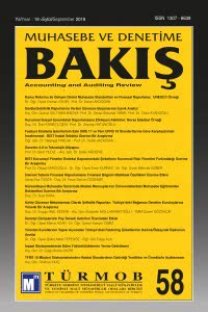YALIN MUHASEBE ARACI SKOR TABLOSU İLE DFMA’NIN FİNANSAL YARARLARININ ÖLÇÜLMESİ
Yalın Muhasebe, Skor Tablosu, Yalın Üretim, DFMA
MEASUREMENT OF FINANCIAL BENEFITS OF DFMA WITH THE LEAN ACCOUNTING TOOL BOX SCORE
Lean Accounting, Box Score, Lean Manufacturing, DFMA,
___
- Ashley, S. 1995. “Cutting Costs and Time with DFMA”, Mechanical Engineering, March, s.74-77.
- Balcı, B.R. 2011. Yalın Finansal Muhasebe, İzmir: Altın Nokta Basım Yayım Dağıtım.
- Bogue, R. 2012. “Design for Manufacture and Assembly: Background, Capabilities and Applications”, Assembly Automation, 32(2), s.112-118.
- Boothroyd, G., Dewhurst, P. ve Knight, W.A. 2010. Product Design for Manufacture and Assembly, Third Edition, CRC Press, Taylor Francis Group
- Deloitte. 2019. Save to Transform As A Catalyst For Embracing Digital Disruption- Deloitte's Second Biennial Global Cost Survey. Deloitte.
- Dewhurst, N.P. 2011. “Product Design: Design First, Lean Second. Assembly, 54, s.62-68. Gao, S., Jin, R. ve Lu, W. (2019). “Design for Manufacture and Assembly in Construction: A Review”. Building Research & Information, DOI: 10.1080/09613218.2019.1660608
- George, B., Mistry, P.M. ve Sheth, S. M. Study and Scope of DFMA and GD&T in Manufacturing Process: A Case Study on Dual Plate Check Valve. 7th International Conference on Advanced Computing and Communication Technologies - ICACCT 2013.
- Kalyun, M. ve Wodajo, T. 2012. “Application of a Design Method for Manufacture and Assembly”. Master of Science Thesis in the Master’s Programme Design and Construction Project Management Department of Civil and Environmental Engineering, Division of Structural Engineering Steel and Timber Structures, Chalmers Universıty Of Technology Göteborg, Sweden 2012.
- Katko, N. 2013. “Measuring the Financial Benefits of DFMA Using the Lean Acconting Box Score” (ftp://ftp.dfma.com/2013pdf/Katko.pdf) Erişim Tarihi:15.01.2020
- Katko, N. 2014. Yalın CFO, Yalın Yönetim Sisteminin Mimarisi, Çeviren: Tunç Sancı, Optimist Kitap, Optimist Yayın No:379, İstanbul.
- Köse, T. ve Ağdeniz, Ş. 2019. “Yalın Yönetim Muhasebesi Aracı Olarak Skor Tablosu”, XI.International Congress on Social Sciences, China to Adriatic, 8-10 Kasım 2019, Bursa.
- Maskell, B., Baggaley, B. ve Grasso, L., (2011). Practical Lean Accounting: A Proven System for Measuring and Managing the Lean Enterprise, Second Edition, New York:CRC Press.
- More, N.K., Buktar, R.B., Ali, S.M. ve Samant, S. 2015. “Design for Manufacture and Assembly (DFMA) Analysis of Burring Tool Assembly”, International Journal of Engineering and Technology”, 2(6), s.843-849. Pirasteh, R.M. - Fox, R. E. 2010. Profitability With No Boundaries: Optimizing TOC and Lean-Six Sigma, ASQ Quality Press, USA.
- Pranav, N.C.D., Warrier, V. ve Jayakrishnan, V. 2017. “Redesigning of Shopping Cart for Cost Reduction Using DFMA”. MATEC Web of Conferences 95. DOI: 10.1051/matecconf/20179510003
- Scohonberger, R.J. 2013. “DFMA- A Lean Potent Methogology”, Assembly, April, s.48-51.
- Spector, R.E. 2006. “How Constraints Management Enhances Lean and Six Sigma”, Supply Chain Management Review, Jan/Feb, 10, 1, s. 42-47.
- Tımár, I., Borbély, T., Lısztes, I.ve Horváth, P. 2010. “Cost Calculations with Method of Design for Manufacture and Assembly (DFMA)”, Fascicle of Management and Technological Engineering, Volume IX (XIX), s.4288-4292.
- Vranson, D. M. 2011. “DFMA vs. Lean”, Assembly, January, s.64-67.
- Yalın Kavramlar Sözlüğü. 2016. Optimist Kitap, Optimist Yayın No:247, İstanbul.
- ISSN: 1307-6639
- Yayın Aralığı: 3
- Başlangıç: 2000
- Yayıncı: TÜRMOB
ALTERNATİF PERFORMANS ÖLÇÜTLERİNİN GELECEĞİ VE DENETİMİ ÜZERİNE BİR DEĞERLENDİRME
YALIN MUHASEBE ARACI SKOR TABLOSU İLE DFMA’NIN FİNANSAL YARARLARININ ÖLÇÜLMESİ
Süleyman EMİR, Özlem Nilüfer KARATAŞ ARACI, Hakki KIYMIK
FAALİYET TABANLI MALİYETLEME: KAMU HASTANESİ GÖZ SAĞLIĞI BÖLÜMÜNDE BİR UYGULAMA
Pınar KURT, Metin SABAN, Fikret ÇANKAYA
MALİ MÜŞAVİR ADAYLARININ FİNANSAL OKURYAZARLIK TUTUM VE DAVRANIŞLARIYLA İLGİLİ BİR İNCELEME
ÜLKELERİN UFRS UYGULAMALARININ KABULÜNDE KÜLTÜRÜN ETKİLEYİCİ ROLÜ ÜZERİNE BİR ARAŞTIRMA
